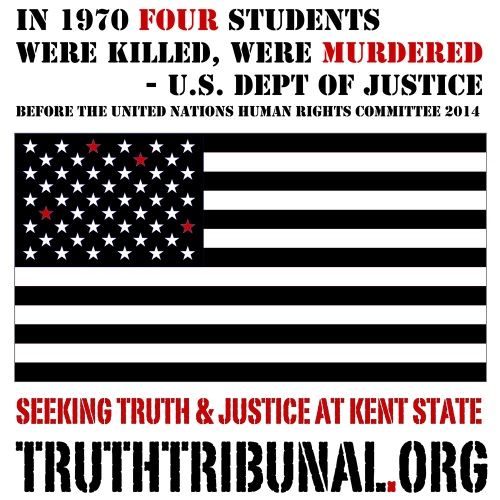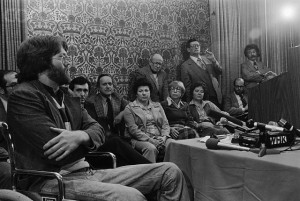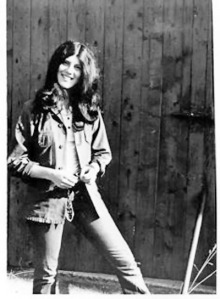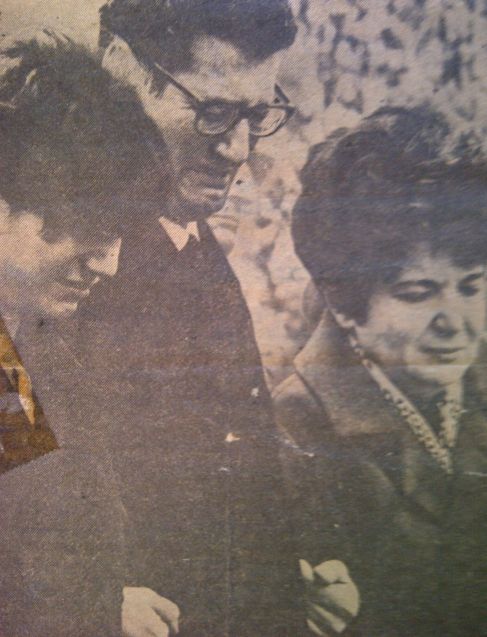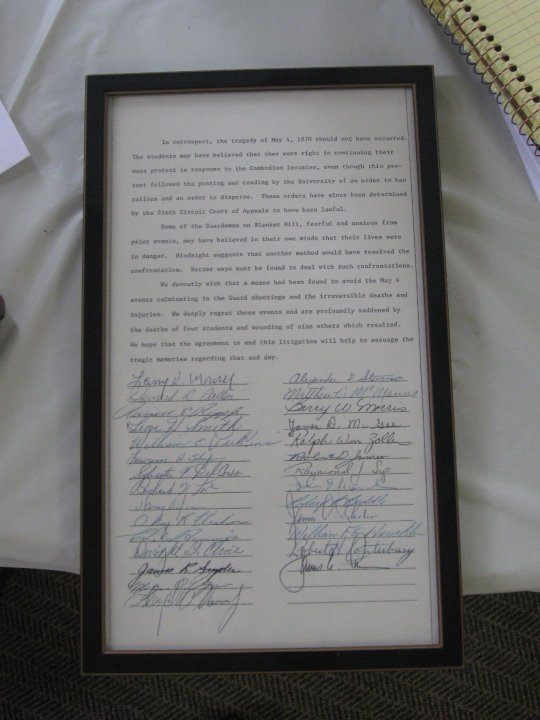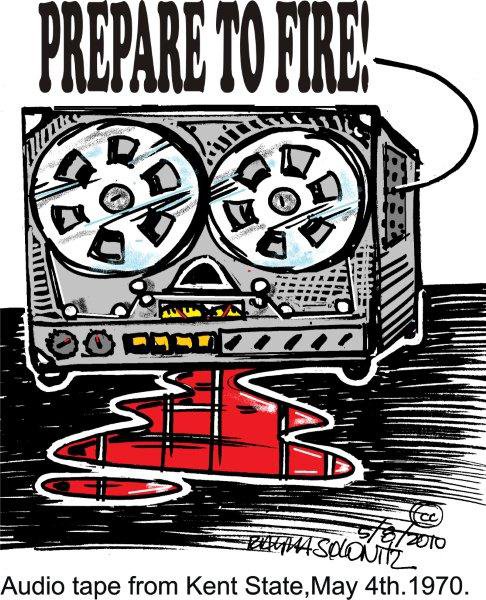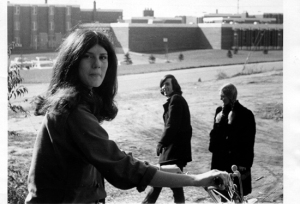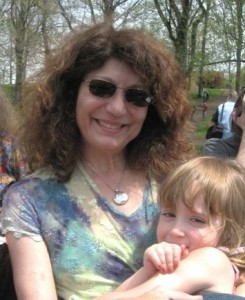On March 1, 2023 as I collected receipts for my 2022 income taxes, I rediscovered old family files of cherished photos from my childhood. Underneath these files at the bottom of the bin, and on its own, I found one single, old postcard. Looking at the addressed side, I quickly recognized the loopy handwriting addressed with my childhood nickname, Laurie. Focusing on the address, I was startled to read writing I hadn’t seen in 53 years. It was a February 22, 1970 postcard from Allison!
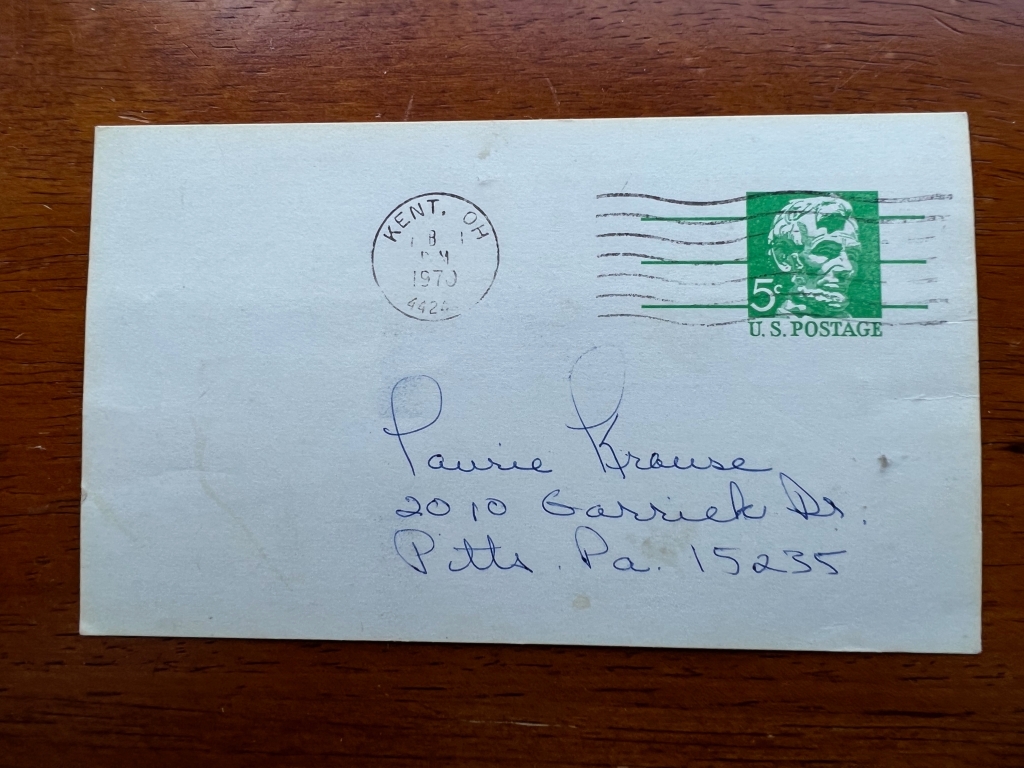

Memories flooded back as I read the postcard. Allison was inviting me to visit Kent State,
“Why don’t you come up for a weekend, Laurie. I’m sure you can train or bus both ways.”
Back in 1970 Allison’s postcard lifted me up from my mundane 9th grade life and I welcomed the opportunity to visit Allison where she was a freshman attending Kent State University. Over the next few weeks we planned for me to take a train to Kent, Ohio and visit Allison over the April 24-26, 1970 weekend.
53 years later it is amazing to have this postcard literally fall in my lap, especially since I had not seen the postcard or read it since 1970. And what a postcard! It included Allison’s music suggestions, her play list, reflecting those times when we were groovin’ to the best rock n roll ever.
Please read my account of that memorable weekend in April 1970 when I visited Allison at Kent State and hung out with her for the very last time.
Visiting Allison at Kent State
It’s April 23rd and Allison’s birthday. I’m in my bedroom in Pittsburgh. I am fidgety and sleepless as tomorrow I am going to visit my big sister at college, just the two of us together for the weekend at Kent State. She had been at Kent since the previous fall but this was my first solo visit to her, my first taste of teenage freedom.
My parents give me permission to skip junior high school that Friday to take the afternoon train from Pittsburgh west to Kent, Ohio. This was no small thing as the Krauses follow the rules and school is most important to them. It will be my first time traveling on my own.
The plan is for us to celebrate over the weekend together as my 15th birthday and Allison’s 19th occur in close succession. Going to plan, on Sunday our parents will meet us in Kent for a double birthday dinner, then I will join them for the return drive to Churchill, our residential area in Pittsburgh.
Ever since the previous autumn of 1969 when Allison moved out of the house at 18 to start college at Kent State University in the honors program, we sorely missed her energy and were all a little lost. Contact with Allison had been curtailed to weekly long-distance phone calls, infrequent letters in the mail and short visits when she was on break. Our family of four was now a family of three and none of us had adjusted to the new configuration yet.
My folks were struggling because their eldest child had grown up and left home. Although it was their dream to send their kids to college, having them walk out the door and leave was another matter.
My experience after Allison left for college was complicated by our family’s recent move from Wheaton, Maryland. Maryland had entered the 1970’s but Pittsburgh was hanging back by a decade or two. I wasn’t happy shifting back in time. On top of missing Allison and becoming the sole kid living at home, I felt on my own in an unfamiliar world, disconnected from my friends and our “with it” life back in Wheaton. Allison only made a pitstop in Pittsburgh, going straight to Kent after setting up her bedroom. I was jealous of her freedom.
Ah, but this morning I begin to feel the dream of what was before me for the weekend. How I was going to be set free from the confines of this uncomfortable new life, released from the repugnant, behind-the-times school system enforcing “no jeans” dress codes and the use of thick wooden paddles to punish students. The best I could hope for in Pittsburgh was to turn on my radio and if I was lucky hear the Beatles, Janis Joplin, Steppenwolf, the Jefferson Airplane and Jimi Hendrix, but only on FM. Today I was going to rejoin Allison, her friends and the rest of the Baby Boomers responding to the trumpets of tumultuous change, and a call for peace, blaring across the U.S.
The move to Churchill came about because Dad was transferred from his position in Maryland back to Westinghouse headquarters. Over the summer we returned to the same Pittsburgh neighborhood where we made our home in 1962, except this time to a new house just around the corner from our old one.
Instead of attending the now legendary Woodstock festival and grooving with more than half a million young people in upstate New York, Allison and I were packing our belongings, forced to leave our comfortable teenage world in Maryland and the buzz of D.C. Television and newspaper headlines around the world heralded Woodstock. We also learned that President Nixon was watching the festival intently, rattled by the size and peaceful energy of this monumental gathering. To my parents, it didn’t matter that their kids didn’t want to move back to Pittsburgh or that we wanted to attend the get-together of the century.
We were living through extreme events that August. Just a week before Woodstock, headlines blasted coverage of Charles Manson and the Tate-LaBianca murders. The press fed off the gory, chilling news of actress Sharon Tate’s killing, she and her unborn child and three guests brutally murdered in L.A. These tragic killings shook America to its core and the public was fed via TV and newspapers that it was the 60’s counterculture that prompted Manson’s murders. Parents were worried for the safety of their teenagers. This made an impression on me and Allison, and we began to understand cultural tensions that were gaining momentum at this time and would later touch our family in profound ways.
Before 1970 our parents were part of the “silent majority,” which meant they were inclined to go along silently in political matters outside of their personal lives. Nixon depended on this acquiescence. With two daughters and no sons, the Vietnam war didn’t touch our family directly but Allison and I were all in, wishing to protect our friends and our compatriots. Then on December 1, 1969, at President Nixon’s direction, the U.S. Selection Service instituted two lotteries to determine those who were to serve in the Vietnam war – the dreaded draft.
We saw firsthand how Allison’s friends, young men her age of 18, were forced to participate in the draft, mostly against their will. U.S. laws didn’t permit anyone under 21 to vote or even drink hard liquor yet they set up this lottery to send 18-plus year-old American boys to their deaths. Young men under 21 had no avenue to have their voices heard about Vietnam or participate in an election to vote against it. These lethal dichotomies struck us to our core.
That August from the crowds at Woodstock and in the streets across the country we saw how young people were sick and tired of taking this BS. Then with the Manson murders as their vehicle, the media and law enforcement vilified us and our counter-cultural world, calling us “dirty hippies.” Even at this young age we understood that there were deeper political forces working to scapegoat young people.
As we loaded our life into boxes and said sad goodbyes to our friends, Allison explained to me how this chapter ending was about more than just moving and leaving our peeps. She clued me in about the change taking place across the United States and in our own home. This was bigger than us. I could always count on my sister to shine a light on what really mattered. And it wasn’t just because she was four years older than me. She inherently understood things far beyond her sphere of knowledge and experience.
In Maryland, Allison and I had finally begun to find support, love and a closeness that we hadn’t felt elsewhere. Maybe it was because we were attending an experimental public school and thrived in the cosmopolitan atmosphere. Or it might have been the times and the people we were running with, but growing up in Wheaton was a high point for us both.
Now it is seven months later and I’m still licking my wounds. I am thankful this trip to Kent has arrived. The thought of a weekend with Allison is already lifting my spirits. It is a welcome change to be living life again, instead of waiting and counting the days.
I hear Mom remind me through my closed bedroom door, “Laurie, you better get a move on or we’ll be late.” I chuckle. With my parents involved, there is absolutely no chance of me arriving late for the train. Even though it takes only half an hour tops to drive downtown to the train station, they want to leave two hours ahead of time. Arriving early is a way of life for my family, at least 15 minutes with 30 even better. Closing my suitcase, I am stoked to get going and start my weekend of independence with Allison at Kent State NOW.
Driving downtown to the train station, Dad’s at the wheel of his forest green ‘67 Chrysler Newport with Mom seated across from him in the front seat. Each workday Dad drove a lengthy daily commute to his Westinghouse job. His car was just about the only place he was permitted to smoke cigarettes unabated. Called “the ashtray,” today it smells like cigarettes and Dad’s cologne, Old Spice. I’m in the backseat in my usual spot, sitting behind Dad, just outside his line of sight in the rearview mirror. L.B. (Lazy Bones) my dog sits in Allison’s spot at the car window across from me, looking out.
Who sat where in the car had been a source of family strife, especially since over the years as a family we spent so much time riding around together in this car. Until recently, Allison sat behind Mom. Even though Allison was away at college, I stayed in the same spot behind Dad – won from our long-fought turf wars for dominance. In the end Allison and I settled for an imaginary line down the center on the back seat and an oath, “You stay on your side, I stay on mine.”
Heading to the Parkway, we drive by our old house on Beulah Road. We lived in Churchill the first time from 1962 to early ‘67. That house represented so much to my parents. How they had made it on their own, fulfilling and living the American Dream. Working at Westinghouse, saving their money and being able to buy a brand-new home in the hillside of their coveted bedroom-community suburb.
Looking out the window of the car during our ride to the train station, the massive forest surrounding the Westinghouse Research Center flies by. Even though for years our house faced the fenced and heavily wooded green space surrounding the Westinghouse R&D facilities, none of us except Dad was ever permitted to set one foot on that property.
Driving on the Parkway we are lucky it is clear with no back-up traffic at the Squirrel Hill Tunnel. That’s the area of Pittsburgh considered the Jewish section. My parents were not interested in moving there, choosing instead Churchill with far fewer Jewish people in the mix. They wanted to buy new construction situated closer to the Westinghouse headquarters for Dad.
Coming into downtown, I see Pittsburgh’s emblematic steel mills and smoke stacks on the river. I gaze at the gigantic rust-colored structures with smoke and fire emitting from steel-mill activity along the banks of the Monongahela River. To me it looks more like industrial art until I remember all the pollution that freely pours out of the mill chimneys into the air we breathe. It creates the black “ring around the collar” on my father’s white business shirts.
Less than a half hour later we arrive at the train station in downtown Pittsburgh. As Dad parks the car, I’m already raring to go. I wait in line to purchase the train ticket that is my 15th birthday present and I’m beyond excited to take my pass to freedom. For my parents, this moment is bittersweet and their mixed feelings are written all over their faces. They’re happy to see me off yet they dread the return to the empty house this weekend. I think they are secretly wishing they could join me – at least that’s how Mom looks. Even though it makes no sense, they’re worried I’ll never come home again and will leave like Allison left. To me it seems they are holding on too tight. I remind them we’ll be together on Sunday for our birthday supper as I kiss and hug them both goodbye thinking, “I’m free.”
Boarding the train and the near-empty car, I select a seat by the window on the right facing west. As the train moves forward, I watch Pittsburgh’s steel mills that line the river valleys turn into farm land and forests of rolling hills. It is a three-hour trip west to Kent.
Ever since I can remember Allison admired Kent State and told us, “That’s where I want to go to college.” As youngsters in Cleveland during the late 50’s and early 60’s, on fair-weathered Sunday afternoons our family would take long drives through the beautiful countryside south, where Kent was located. Allison’s first choice for college had become a reality so here I am on a train, on my way solo to meet Allison living her college dream.
I remember the last time we were all in Kent in the fall of 1969 to take Allison to campus. With L.B. in tow, we drove to Kent State to move her into a dormitory to begin her studies. On the trip from Pittsburgh, Allison was bursting at the seams; she couldn’t wait to begin her adult life of independence and this new chapter.
Arriving on campus, we moved her belongings into Metcalf Hall located in an outer region of the Kent State campus. Allison wasn’t happy about being so far out or sharing a room with three other young women – she had never shared her bedroom before and treasured her privacy. Right after the holidays in the new year, Allison finagled her move to another dormitory room at the center of campus, a single in Engleman Hall. I will be staying with her there for the weekend, just the two of us in her dorm room.
I think about how grateful I am we began forging our peaceful sisterly bonds back in Wheaton. We attended an experimental public school system that mixed grades in classes, enabled free thinking and offered an open campus. I was in junior high but at John F. Kennedy High School, Allison benefited from a full-blown ‘60’s experiment with innovations in teaching, in particular fostering independence. In this fertile and positive environment, we found solidarity easier to nurture between us. We made peace with each other, leaving behind our family-taught ways of bickering and bullying.
Allison turned me on to pot a year earlier, but not without a lot of coaxing and negotiation. Over chats in our neighboring woods behind the Glenmont shopping center with friends my age who also had older brothers and sisters, we suspected our older siblings were smoking marijuana, and probably taking L.S.D. and mushrooms.
Among my friends, I was nominated to ask Allison to help us get some. I knew for sure she was getting high and we all felt Allison to be the most approachable among our siblings.
Not long after our conversation in the woods, I knocked on Allison’s bedroom door and she let me in. With Jimi Hendrix’s Are You Experienced? playing on her record player, an album we bought together, I asked her if she would turn me on. She was caught off guard. I told her I knew she was smoking marijuana, that I was asking for me and my friends, younger sisters of her friends, and that we would pay for it. Allison said she’d have to think about it and get back to me.
Days later, still not hearing back, I asked Allison if she had made her decision. In her room, away from our parents, she told me, “I’m not going to be able to help you.” I was crestfallen and really pissed, knowing Allison was my only shot.
I told her if she didn’t help me, I’d be forced to go elsewhere to score. That if I was busted or had trouble from a stranger, she’d get it from our parents, even worse than me. I told her I needed her experience and connections. She knew I was right and grudgingly acquiesced. Then, ever the negotiator, she insisted I go in with her on a water pipe she found at the smoke shop at Wheaton Plaza. Later that week we bought that pipe made of amber glass with a carved wooden bowl elegantly packaged in a box lined with cobalt blue fabric.
It felt like a sacred ceremony when Allison turned me on to marijuana in her bedroom. Adding water to the pipe, Allison’s eyes sparkled with anticipation and generosity as she filled the wooden bowl with keef, powdered hash composed of raw cannabinoids. One of the finest grades of marijuana available then, and probably still. Using the water pipe, we toked up together and I got high on the first try.
Speeding west on the railroad tracks, I remember how there are still issues to be navigated and healed but I am looking forward to getting stoned with my sister again.
As the Kent, Ohio train stop nears, I gather my suitcase and stare out the window anticipating our magnificent weekend. When the train slows to a stop, I step off into the center of town. As I stand on the sidewalk, the cars whizz by in late day traffic and I search faces of pedestrians for Allison. Her statuesque presence and electric energy are nowhere to be found. Over my shoulder I notice the Cuyahoga River and remember Dad’s stories about how just last summer the river caught fire, fed by decades of dumped toxic waste.
Then I see Allison rushing toward me, arriving out of breath and with a big smile and hug hello. “Sorry I’m late” she explains and adds, “I had a class and came here as soon as I got out.”
Even though it’s late April, we’re both still wearing our winter coats because spring has barely sprung. The weather is cold and damp with few lilacs nearing bloom. We walk together through town toward the Kent State University campus. Passing by the Kent Stage, the town cinema and night club, we see the movie Woodstock written on the marquee and smile. Allison shares, “Tomorrow night we are thinking of going to see Woodstock, the movie” and asks if I want to join her and her boyfriend Barry. You bet I want to go!
Woodstock was a big deal for us and just about every young person across the U.S. Nine months earlier in August of ’69, the outdoor concert was held in upstate New York over three days of peace, love and harmony set to the best rock ‘n roll of our generation. An audience of more than half a million revelers, people just like us, camped out in nature and immersed themselves in the intoxicating music. They all took care of each other and shared a deep sense of community and mutual support that would define the hopes of this era. Woodstock broke the ground for a period of peaceful self-expression that would be remembered for decades to come. But even though Allison had graduated high school and was 18 years old, she was not allowed to attend Woodstock. She had been grounded and forbidden by my mom.
It happened one day when Mom was unexpectedly home early from work. When she delivered clean, folded laundry to Allison’s unattended room she found what she considered “a rat’s nest.” It wasn’t dirty, just messy with her bed unmade, but this was unacceptable in our house. Mom decided to clean it up and discovered what no parent wished to find: pot, LSD, mescaline, our amber glass water pipe – and the clincher, birth control pills.
At 14, I was too young to consider Woodstock and never bothered to ask. That afternoon when Mom went into Allison’s room, I was home and heard it all from my bedroom next door. I waited for Allison on our front stoop, to warn her. When she came home from her job at the Hecht Company department store, she was struck and paralyzed by the news. She wanted to know all the details about how Mom went through her room and found everything. Taking a minute to gain her bearings, Allison courageously headed inside to face the music. Before Dad arrived from work that night, Allison had made a deal with Mom. She would not go to Woodstock and was grounded in exchange for Mom not telling Dad about her findings.
With Woodstock never to be for us, watching Woodstock the movie was the next best thing.
Even though it had been cold and damp from weeks of rain, on our walk across campus to Allison’s dorm I am enthralled to be in a world I had never experienced before. Young people older than me, long hairs and many more straights, dart about on campus, bustling off to their classes and getting on with their lives. I see Kent State has a large faction of jocks and straights but my eyes are trained on the freaks populating the campus, and there are many. My imagination takes off as I pretend I’m older and one of them.
Arriving at Allison’s dormitory, I enter her accommodations and drop my bag. In her new digs there is a small sink in the corner and I feel like we are in a Vincent Van Gogh painting. A poster of Odilon Redon’s Evocation of Roussel decorates her walls along with peace posters. Academic books, esoteric studies such as the Tibetan Book of the Dead, candles and tokens of peace are stacked high on her bookcase.
Later that evening Allison and I walk across the campus to hang out with Allison’s boyfriend Barry Levine at his dorm. Allison and Barry had fallen in love at Kent State that autumn and had become inseparable ever since. My parents and I had met with Barry several times and were very fond of his dry sense of humor, gentleness and how happy he made Allison. That first night, feeling all grown up hanging in the men’s dorm, I get high with my sister and Barry and feel part of it all. Even though I’m just 15 years old, I am grooving on the Kent State University campus as I play pool in my Landlubber bellbottom jeans and tie-dye t-shirt. Life is sweet!
Saturday night the wait line for the Woodstock movie winds around the block and it’s a peaceful and happy crowd. Allison doesn’t mention until afterwards how earlier in Kent folks standing in line for Woodstock had been attacked by unruly people cruising by in cars, throwing stuff at those waiting, getting ticket holders wet and freaked out as they yelled “dirty hippies.”
Woodstock does not disappoint. We’ve never experienced a movie like this before, and it’s not just because we’re high. This was a new kind of concert film that had just emerged as an artform, and it was out to the public in what seemed like minutes, too. Folks in the audience are standing up, dancing to the music and clapping along, and we join right in.
Woodstock spoke directly to our generation, capturing the groove of our age. It crystalized the magnificence of what a time it was, a time of peace, love and understanding. The music captured that promising energy and carried us in hope and solidarity for the future. We needed it later in our struggle when the cultural and political repression began to gain momentum. But that night with Allison and Barry, it was all inspiration; I will never forget it.
Celebrating Earth Day April 22, 1970
Waking up on Sunday in Allison’s dorm room, the dread has already set in. My great weekend escape from my parents’ home into college life is coming to a close too quickly. As I pack my bag for the return to Pittsburgh, Allison says it’s fine for me to take her April 24th copy of the Daily Kent Stater college newspaper, so I stuff it into my bag.
Around noon Mom and Dad arrive and our visit turns into a birthday celebration. On March 22nd I had turned 15 and last week, on April 23rd, it was Allison’s 19th birthday. We enjoy a loving birthday dinner together with the family and Barry at the Brown Derby, one of the best restaurants near Kent State.
For the Krauses this birthday dinner signified a rare moment of peace at the dinner table. Over the last few years, so many meals turned into a raging battlefield between Allison and Dad, especially over the Vietnam War and what Dad did for a living. Not so at our dinner together this night. Everyone is on their best behavior, desperately wishing to create loving memories of our family gathered together in peace.
Allison and Barry share their news. Their studies at Kent State have been a disappointment. They don’t want to continue their courses there for another year and have made applications to transfer to S.U.N.Y. at Buffalo, not far away. To them Kent State is behind the times, stifling and too regimented. Both have been accepted to attend so Allison and Barry are planning their sophomore year at S.U.N.Y. in the fall of 1970. My parents’ reactions are positive. They are okay with Allison transferring because they don’t want her to drop out of college.
After dinner we drive Allison and Barry back to campus and my weekend visit comes to a close. With my father at the wheel, we head back to Pittsburgh. It’s April 26, 1970 and it is the last time we see Allison alive.
That night back in my bedroom in the family home, I unpack my bag and settle in to read the Daily Kent Stater. On the cover is an amazing structure of a geodesic dome erected on the Kent State University Commons days earlier, for the first Earth Day. The article says it was built in homage to Buckminster Fuller, an American architect, designer, inventor and visionary. Fuller is now remembered as a wildly popular counter-cultural figure because of his early embrace of environmentalism and egalitarian futurism, but at the time he was at the height of his public fame yet marked subversive by the authorities. The Ecosphere at Kent State is an initiative led by Kent State architecture students hoping to spend the night inside their newly constructed dome, a structure built on sacred geometry. I’m fascinated by Bucky’s prescience but note that the dome was nowhere to be found by the time I arrived on campus.
Allison and I had separately honored the first Earth Day just days earlier on April 22, 1970 when young people around the world focused on protecting Gaia and developing strategies to heal our planet. Earth Day efforts were mostly ignored by those in authority wishing to maintain the status quo. They were wholly unsympathetic to these first activities in the environmental movement and coined the phrase “The environment is a dirty word.” Dirty indeed, especially with the Cuyahoga River on fire in Ohio and the first big oil spill in Santa Barbara taking place just months before.
Headlines were full of environmental disasters by the end of the 1960’s. The previous June the Cuyahoga River flowing south from Lake Erie caught on fire following decades of chemical and oil spills. Prior to this, millions of gallons of crude oil leaked from a blowout of an oil drilling platform off the Santa Barbara coast. Extinction threats were drawing public attention, including the bald eagle, the national symbol of the U.S.A., and of course the whales. In response to this devastation, former Wisconsin governor and senator Gaylord Nelson founded and inspired the first Earth Day in 1970 which galvanized over 2,000 universities and 20 million Americans across the country, as well as participants around the world. Kent State was one of the universities taking part.
Allison’s first Earth Day on her Kent State campus was far more eventful than mine. Even in Pittsburgh, my suburban junior high school had a mini teach-in but I opted to join adults and college students at a city-wide Earth Day event. Nearly a 1,000 residents of Pittsburgh gathered on Flagstaff Hill in Oakland, adjoining the Carnegie Mellon University campus. It was a teach-in filled with inspiring speakers, festive music and folks with tables hawking their grassroots causes, all of us honoring the EARTH. I learned a lot about what I could do as an average young person to fight the problems of environmental degradation, and this was long before these issues permeated popular culture. We honored Gaia that day.
Over the weekend Allison mentioned she had attempted to hear Ralph Nader, the keynote speaker at Kent State University on the first Earth Day. The Daily Kent Stater I am reading grabs my attention, “One of the first things Nader said when he stood at the podium in University Auditorium was: ‘Don’t you have a gymnasium here?’ He was addressing more than 1,500 students in a room that seats only a thousand. Those who could not fit in the auditorium waited in Wills Gym and listened to WKSU radio broadcast Nader’s remarks over the loud speaker. The whole evening smacked of poor planning and poor coordination. It was an embarrassment for the university and a cause for anger on the part of concerned students who wanted to hear the consumers’ crusader’s remarks in person… Police estimated that more than 4,000 persons who wanted to hear the speech by Ralph Nader in University Auditorium Wednesday night had to be turned away.” It was obvious that Kent State University wished to censor Nader and eclipse his impact.
As environmental activists raised their voices across America on that first Earth Day in 1970, the Nixon administration and leadership at universities like Kent State took detailed notes on the young people who were making change. Although we were oblivious at the time, there is not vast documentation about the unprecedented level of surveillance of students ramping up in this period. Those in charge had also been busy infiltrating counter-cultural organizations to gather intelligence, spy on and harass those who dared to care about the environment. The CIA was driving much of this in their CHAOS program directed against young people and those who stood against war and for the environment, two issues often linked at the time. There was a burgeoning movement to confront corporations that polluted the Earth and the powers that be were not going to stand by and watch. Surveillance was the precursor to repression as environmental protests eventually led to demands for corporate accountability. Our actions were deeply threatening and in response the suppression of protest was nefarious and palpable.
Additionally, a seismic political event was taking place. Nixon had established the draft lottery, the first policy for compulsory service since WWII, essentially trapping young people to fight in the Vietnam War. This Daily Kent Stater reported Nixon’s announcement to end the deferments that had exempted those attending college, married students and workers – all categories that until this point provided ways to avoid the draft. This unwanted news reverberated across U.S. campuses, including Kent State.
Back then peaceful U.S. college students were trying to take every avenue to get out of serving in Vietnam, while President Nixon was finding every way he could to limit their ability to defer their service. The Daily Kent Stater reported: “The White House explained in a fact sheet accompanying the President’s message to Congress that as of Thursday, [April 23rd and Allison’s birthday] students already attending college, or junior or community college, or an approved technical school, continue to be eligible for student deferment. Those planning to enroll in the future, however, will not be eligible for student deferment.”
Reading my newspaper from the weekend visit with Allison, I savor the memories of our bittersweet slice of life together on campus that April weekend. At this point I have no idea what is in store for Allison and my family, or how what is about to happen will affect us for the rest of our lives.
—
READ MORE EXCERPTS to understand our view of what happened to Allison Krause in the May 4, 1970 Kent State massacre:
May 1, 1970 with Allison Krause at Kent State University https://bit.ly/3ViLlBm
May 2, 1970 with Allison Krause at Kent State University https://bit.ly/3Hy3vcv
May 3, 1970 with Allison Krause at Kent State University https://bit.ly/3Vv3oUN
May 4, 1970 with Allison Krause at Kent State University https://bit.ly/3ARaFoJ
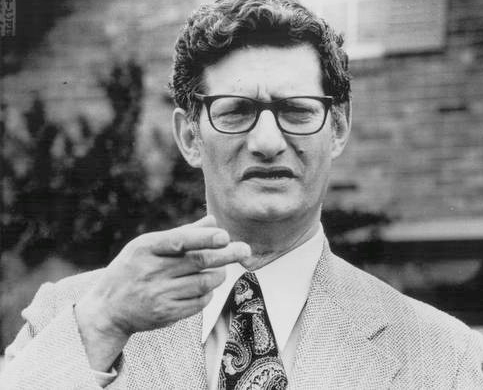
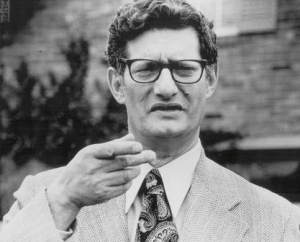 By Shane Harris, published on June 1, 2012 in the
By Shane Harris, published on June 1, 2012 in the  My name is Carlos Jones. I am a musician. I live in Cleveland, Ohio – Shaker Heights to be exact. I’m here today at the request of the family of Allison Beth Krause, to speak for her as we commemorate the 49th year since that particular tragedy.
My name is Carlos Jones. I am a musician. I live in Cleveland, Ohio – Shaker Heights to be exact. I’m here today at the request of the family of Allison Beth Krause, to speak for her as we commemorate the 49th year since that particular tragedy.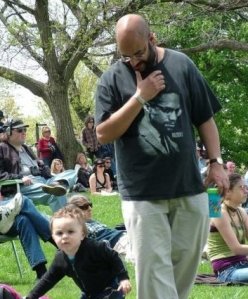 This year marks my 28th commemoration. I have spoken only once for a student, Jeffrey Miller. In my younger years as a student, I thought that Jeff was the one who I had the most in common with—like him, I considered myself a young revolutionary who deeply believed in activism and civil rights. I didn’t realize how much I have in common with Allison until this year.
This year marks my 28th commemoration. I have spoken only once for a student, Jeffrey Miller. In my younger years as a student, I thought that Jeff was the one who I had the most in common with—like him, I considered myself a young revolutionary who deeply believed in activism and civil rights. I didn’t realize how much I have in common with Allison until this year.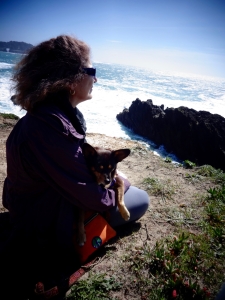 When I first chose to write this paper on Laurel Krause, I was expecting it to be just like any other short research paper on a human being. Read up on their accomplishments, read some interviews, look up different articles, et cetera, et cetera. Little did I know that I would have the wonderful opportunity to sit down and have a phone conversation with Laurel herself. It was a quiet Sunday afternoon on May 1st when I decided to make the call – I had been mulling over the decision as to when to call since hearing back from Laurel. I was extremely nervous to call and make a fool of myself.
When I first chose to write this paper on Laurel Krause, I was expecting it to be just like any other short research paper on a human being. Read up on their accomplishments, read some interviews, look up different articles, et cetera, et cetera. Little did I know that I would have the wonderful opportunity to sit down and have a phone conversation with Laurel herself. It was a quiet Sunday afternoon on May 1st when I decided to make the call – I had been mulling over the decision as to when to call since hearing back from Laurel. I was extremely nervous to call and make a fool of myself.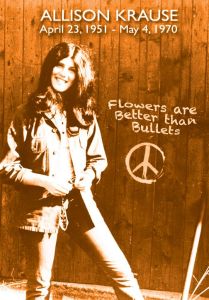 Another May 4th parent has died since last we gathered to commemorate this event. Another mother has left us before the truth is clear and justice is served. My aunt,
Another May 4th parent has died since last we gathered to commemorate this event. Another mother has left us before the truth is clear and justice is served. My aunt, 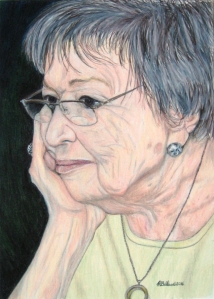 Last week while I was walking along the California coast near my home, I was called to my mother Doris Krause’s bedside by hospice caregivers informing me that her time was near. Mom had stayed in Pittsburgh, our family home, perhaps for the same reason I went very far away. We shared a tragedy in our family that broke our hearts and wounded our spirits but ultimately deepened the love between us in ways we might not have otherwise known. We have carried this wound for so many years but I arrived back home in Pittsburgh to experience a profound healing with Mom. I am moved to share our experience as we lay her body to rest.
Last week while I was walking along the California coast near my home, I was called to my mother Doris Krause’s bedside by hospice caregivers informing me that her time was near. Mom had stayed in Pittsburgh, our family home, perhaps for the same reason I went very far away. We shared a tragedy in our family that broke our hearts and wounded our spirits but ultimately deepened the love between us in ways we might not have otherwise known. We have carried this wound for so many years but I arrived back home in Pittsburgh to experience a profound healing with Mom. I am moved to share our experience as we lay her body to rest.